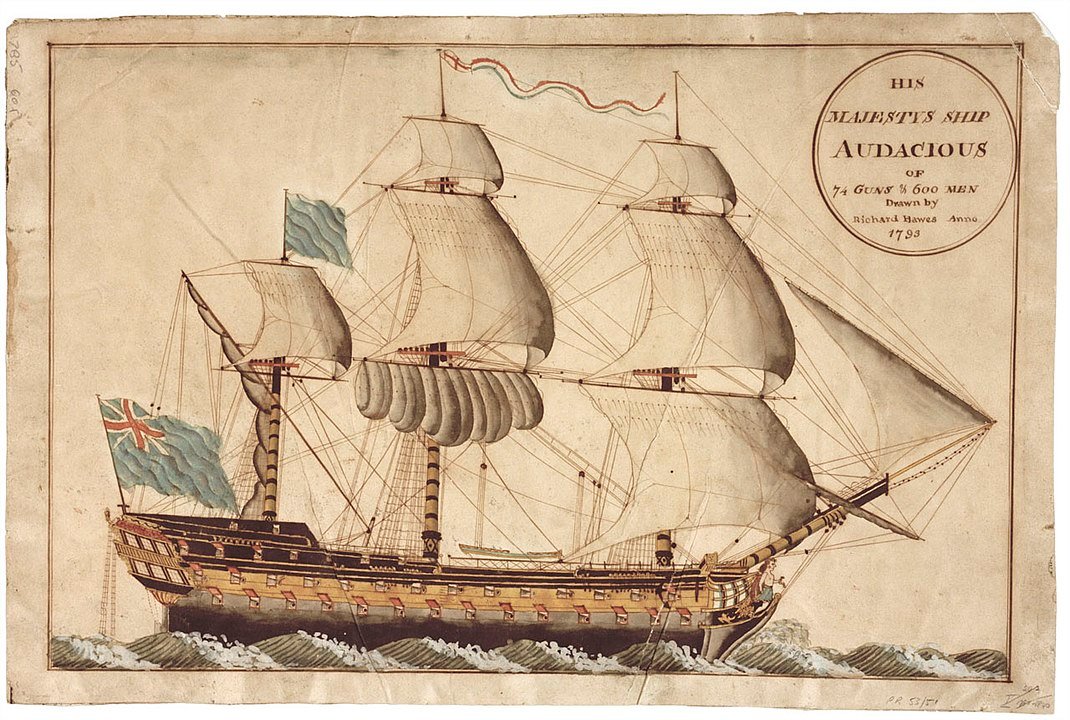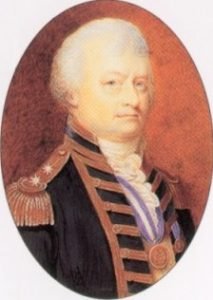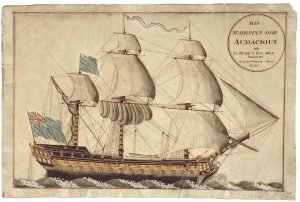Sir William Parker
1743-1802. He was born on 1 January 1743, the eldest son of Augustine Parker, a naval officer who commanded the royal yacht Queenborough, and who became mayor of the town of Queenborough on the Isle of Sheppey, and of his wife, Elizabeth Beal. A younger brother was Captain Robert Parker.
In 1756 Parker entered the Navy, and he served aboard the Centurion 50, Captain William Mantell, at the reduction of Louisbourg in 1758 and at the capture of Quebec a year later. He remained in the Centurion under the command of Captain James Galbraith, going out to Africa in 1760 then Jamaica in the following year before returning to England in 1762 when he passed his lieutenant’s examination.
In April 1764 he went out to Newfoundland aboard the Guernsey 50 with Captain Hugh Palliser, who had been appointed the lieutenant-governor and commander-in-chief of that territory, and he was an assistant to James Cook aboard the schooner Grenville when the future explorer undertook a survey of the Newfoundland coast. He left the Grenville when she returned to Deptford in November 1766, having touched at Falmouth in the previous month, and he was commissioned lieutenant on 29 November. In April 1768 he returned to Newfoundland aboard the Niger 32, Captain Andrew Wilkinson, which vessel came home via Cadiz in March 1769, and which then went out once more to Newfoundland in May 1770 to return home in November of that year.
His service in Newfoundland waters resumed when he commanded the schooner Egmont 10 from April 1771, arriving at Harbour Breton in November where he was ordered to lay up for the winter. Unfortunately a fire destroyed a house which had lodged much of his vessel’s stores, provisions, sails and rigging, in addition to his personal possessions, leaving him in straitened circumstances during the most bitter of seasons. Once back at sea he cruised off St. Pierre and Miquelon, remaining with the Egmont until she was paid off at Gosport in October 1772.
Parker commanded the Anson 6 from March until June 1773 at Poole, and he was promoted commander of the sloop Senegal 14 on 25 June 1773, which vessel was at the time undergoing a repair at Sheerness. In the following February he was appointed to the Nautilus 16 which was ordered to be fitted out for service at Newfoundland, and he sailed for the familiar territory in April, prior to arriving back at Portsmouth in early December. In January 1775 he took the Senegal around to Plymouth, and in March recommissioned the sloop Martin 14 at Chatham, going out to Newfoundland in June and retaining her until the following January.
On 28 August 1777 he was posted captain of the new Sultan 74, which was waiting to be commissioned at Chatham, but in November he removed to the Deal Castle 24 and went out with a convoy from Portsmouth to the Leeward Islands during the following month. In October 1778 he arrived back in the Downs with the homeward-bound Leeward Islands convoy, and he then escorted a number of ships around to Portsmouth where the Deal Castle was docked in preparation for a return trip to the West Indies, a voyage which she made at the end of the year. During the early part of 1779 the Deal Castle was attached to Vice-Admiral Hon. John Byron’s fleet off St. Lucia.
In May 1779 Parker succeeded Captain Alan Gardner aboard the frigate Maidstone 28 in the Leeward Islands, and he arrived at Portsmouth on 10 October having given passage home to Vice-Admiral Byron. During December his command was docked at Chatham, and in March 1780 she sailed for Lisbon and Newfoundland. Whilst in company on 23 June with the Cygnet 14, Commander Thomas Drury, Parker captured a rebel privateer brig from Salem, the Saratoga. On 27 July the Maidstone left St. John’s with the Quebec and Newfoundland convoy, but by October was back on the Newfoundland Banks where she had to survive a severe hurricane. She returned to Portsmouth with despatches in December, and was promptly sent out on a cruise. By March 1781 she was at Portsmouth, and after departing for Newfoundland once more in May she took the privateers Oliver Cromwell on 7 July, the Lyon 10 from Salem off Cape Chaperouge on 2 August, and the Montgomery three days later. After coming home at the end of the year the Maidstone was paid off in January 1782.
In October 1781 Parker had been appointed to the Iphigenia 32 in succession to Captain Charles Hope, although it appears that the latter continued with the Iphigenia until the early spring of 1782 when his new command, the Leocadia, became available for service. The Iphigenia returned from Elsinore with a convoy in July 1782 and began fitting out at Chatham in November, before in December she left Spithead for Cork with a convoy of transports and storeships. By January she was back at St. Helens, and she put into Plymouth in early February after being partially disabled in the Bay of Biscay whilst forming part of a small squadron under the orders of Captain Robert Brice Kingsmill that had apparently with secret orders to attack Spanish possessions in South American before sailing around Cape Horn to join the East Indies squadron in an attack on Manila. The Iphigenia re-entered Portsmouth on 10 March 1783 and was paid off shortly afterwards.
For three years, from the summer of 1783 until the spring of 1786, Parker was the captain of the newly commissioned guardship Dictator 64 in the Medway, with the most excitement arising in April 1784 when one of his midshipmen was confined to Maidstone Gaol for highway robbery. In February 1787 he hoisted his broad pennant aboard the Jupiter 50 at Portsmouth as the commander-in-chief of the Leeward Islands station in what was to prove another uneventful tenure, with his pennant ship returning to Portsmouth on 10 June 1790 after a passage of thirty-five days from Barbados. Following his arrival home he briefly commanded the Formidable 90 as part of the force raised during the Spanish Armament of 1790, but upon the dispute resolving itself in the autumn she was paid off.
Parker commissioned the new Audacious 74 in December 1792, and in April 1793 sailed from the Downs for Portsmouth to join the Channel fleet, going out in May in search of several French frigates, and participating in the cruises of July-August and October-December. On 28 May 1794, during the days leading up to the Battle of the Glorious First of June, he fought a gallant action against the French Révolutionnaire 110, with the probability of taking her nullified by the arrival of French reinforcements. The badly damaged Audacious was almost cut off by the French, and being raked for almost an hour by the fire of the frigate Bellone 36 she could do nothing more than escape in haste to reach Portsmouth on 1 June, thereby missing the battle.Her casualties in the action amounted to six men killed and twenty-four wounded.
On 4 July 1794, Parker received his elevation to flag rank, the general promotion being extended to include him, and it was reported that as the commander of the Channel Fleet’s flying squadron he would continue in the Audacious with Captain Alexander Hood.
On 10 November 1794 at Portsmouth he hoisted his flag on the Raisonnable 64, commanded by his younger brother, Captain Robert Parker, and gathering up a convoy at Torbay and Plymouth in the last days of December he headed out for Jamaica to serve as commander-in-chief. Here he would be criticised for not preventing the replenishment of Cap François by two French squadrons, and he also failed in an attack on Léogane, San Domingo on 21 March 1796, although he did well to assist the army on that island. Unfortunately his tenure, during which his captains uniquely agreed to split all the prize money they earned, was curtailed by yellow fever, and before his successor, Vice-Admiral Sir Hyde Parker, had even arrived at Jamaica he returned to Portsmouth in September aboard the Swiftsure 74, to which he had removed earlier in the year with his brother.
In December 1796 Parker raised his flag on the Prince George 98, Captain John Irwin, and putting to sea with Admiral Lord Bridport’s Channel fleet in early January 1797 he proceeded to reinforce Admiral Sir John Jervis at Lisbon with five sail of the line. Five days after uniting with Jervis he was fourth-in-command at the Battle of Cape St Vincent on 14 February where his flagship, the third in the line of battle, fought the San Josef 112 to a standstill, and drove her into the San Nicolas 84, although these ships were later boarded and captured by Commodore Horatio Nelson. During the battle the Prince George suffered casualties of eight men killed and seven wounded. Parker subsequently betrayed some resentment at Nelson’s dramatic account of the battle and drew up his own report which countered much of his subordinate’s claims, and which received the concurrence of the captain of the fleet, Captain Sir Robert Calder. It is probable however that both men were justified in their differing views of the engagement.
He was created a baronet on 24 June 1797 and received sundry other rewards, including the position of second-in-command following the sacking of Vice-Admiral Charles Thompson. Nevertheless, to his bitter resentment during the summer of 1798 he was overlooked for the detached command of a squadron sent into the Mediterranean in favour of Nelson, being sated only somewhat by Admiral Lord St Vincent, who indicated, distortedly, that the selection of Nelson was entirely an Admiralty decision. The crusty commander-in-chief changed his tune once the Battle of the Nile had been won by Nelson on 1 August, whereupon he claimed the credit for himself in choosing Nelson for the independent command.
Remaining with the greater portion of the Mediterranean fleet, Parker cruised off Cadiz throughout the rest of 1798, and he was promoted vice-admiral on 14 February 1799. Flying his flag aboard the Prince George 98, Captains William Bowen and thereafter his son-in-law, Joseph Bingham, he participated in Vice-Admiral Lord Keith’s chase of the Brest fleet following it’s breakout on 25 April before leaving the Mediterranean station and being presented to the King on his return home towards the end of October, it being intended that he go out to North America as the commander-in-chief.
In May 1800 he finally went out to Halifax as the commander-in-chief with his flag in the America 64 commanded by Captain Bingham, and where he replaced the late Admiral George Vandeput, who had died on 14 March. After taking command at Halifax on 18 August, he independently despatched his flagship and the Cleopatra 32, Captain Israel Pellew, on a cruise to the West Indies, a transfer of resources off his station which actually required the Admiralty’s authorisation. To make matters worse the America went aground on the Formigas Rocks off the Azores on 13 December, and although she was salvaged it was only to serve as a prison hulk at Port Royal. Jamaica.
Once the new first lord of the Admiralty, Admiral Earl St. Vincent, learned of Parker’s indiscretion he ordered his recall to face a court martial, and being given just twelve hour’s notice from the receipt of this instruction Parker set sail from Halifax for England on 9 July 1801 aboard the St. Albans 64, Captain John Oakes Hardy, to arrive at Portsmouth with a convoy on 6 August. Following his subsequent court martial presided by Admiral Sir Thomas Pasley aboard the Gladiator 44 at Portsmouth over 13-14 November he was censured for being indiscreet, but acquitted of any charge on account of his esteemed record. St. Vincent received some criticism from his political enemies for ordering the trial in the first place, and given the first lord’s renowned malignancy there was much speculation that the case had been brought through resentment of the fact that a year earlier Parker had fought and won a legal case against his old commander-in-chief over the sharing out to flag officers of freight money.
Upon going ashore in Portsmouth after the court-martial Parker was serenaded by church-bells and heralded by the populace. He was also given some expectation of a prompt recall to the colours, but unfortunately the peace with Britain’s enemies arrived first.
On 31 December 1802 Admiral Parker died from apoplexy at his residence of Beaufort House, Ham near Richmond in Surrey. He was buried in a vault at St. Alfege Church, Greenwich. He left £50,000, equivalent to £4.5m in today’s money, in his will.
Parker married Jane Collingwood of Greenwich, the daughter of a naval captain, at St. Nicholas Church, Deptford on 28 December 1766. The couple had seven daughters and a son, William George, who was born in August 1787, entered the service on the Raisonnable with his father in 1794, fought with him at the Battle of Cape St. Vincent, was for some time flag-lieutenant to Admiral Sir John Duckworth at Newfoundland, was promoted captain in 1814, and died as a vice-admiral in 1848. One of their daughters, Jane, married Captain George Cook of the Navy, another, Sarah, married Rear-Admiral Joseph Bingham, whilst Susannah married Captain William Hawkwell Bowen of the Navy, and Mary married Colonel Peter Roberton.
As a consequence of his shipwrecking in Newfoundland as a young man Parker became a slave to rheumatism in later life. He was described as ‘proud’ and ‘pompous’, but keen to ensure fair play.




